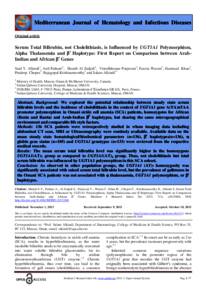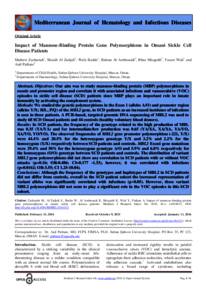وثيقة
Serum total bilirubin, not cholelithiasis, is influenced by UGT1A1 polymorphism, alpha thalassemia and β<sup>s</sup> haplotype: First report on comparison between Arab-Indian and African β<sup>s</sup> genes.
المعرف
DOI: 10.4084/MJHID.2015.060
المساهمون
Pathare, Anil., مؤلف
Al-Zadjali, Shoaib., مؤلف
Panjwani, Vinodhkumar., مؤلف
Wasim, Fauzia., مؤلف
Khan, Hammad., مؤلف
Chopra, Pradeep., مؤلف
Al-Kindi, Salam., مؤلف
الناشر
Universita Cattolica del Sacro Cuore.
ميلادي
2015-11
اللغة
الأنجليزية
الموضوع
الملخص الإنجليزي
Background: We explored the potential relationship between steady state serum bilirubin levels and the incidence of cholelithiasis in the context of UGT1A1 gene A(TA)nTAA promoter polymorphism in Omani sickle cell anemia (SCA) patients, homozygotes for African (Benin and Bantu) and Arab-Indian βS haplotypes, but sharing the same microgeographical environment and comparable life style factors. Methods: 136 SCA patients were retrospectively studied in whom imaging data including abdominal CT scan, MRI or Ultrasonography were routinely available. Available data on the mean steady state hematological/biochemical parameters (n=136),βs haplotypes(n=136), α globin gene status (n=105) and UGT1A1 genotypes (n=133) were reviewed from the respective medical records. Results: The mean serum total bilirubin level was significantly higher in the homozygous UGT1A1(AT)7 group as compared to UGT1A1(AT)6 group. Thus, not cholelithiasis but total serum bilirubin was influenced by UGT1A1 polymorphism in this SCA cohort. Conclusion: As observed in other population groups, the UGT1A1 (AT)7 homozygosity was significantly associated with raised serum total bilirubin level, but the prevalence of gallstones in the Omani SCA patients was not associated with α thalassaemia, UGT1A1 polymorphism, or βs haplotypes.
المجموعة
ISSN
2035-3006
URL المصدر
قالب العنصر
مقالات الدوريات


